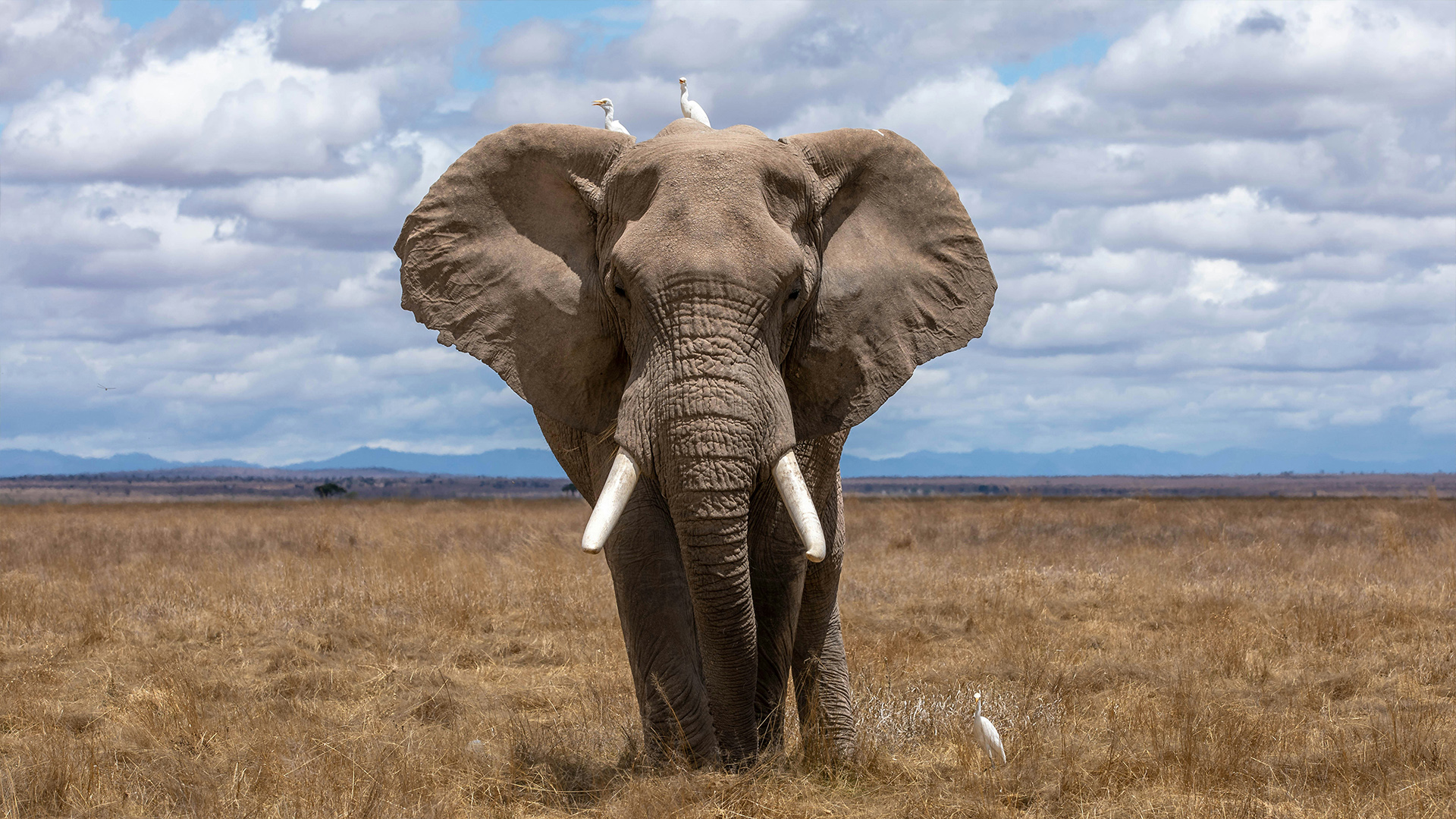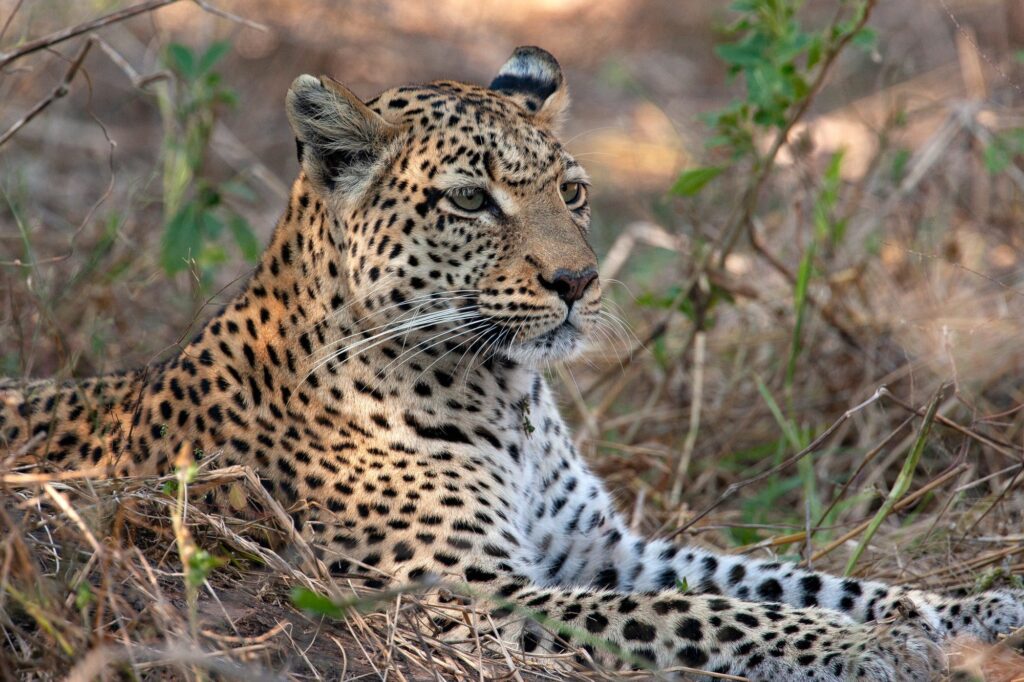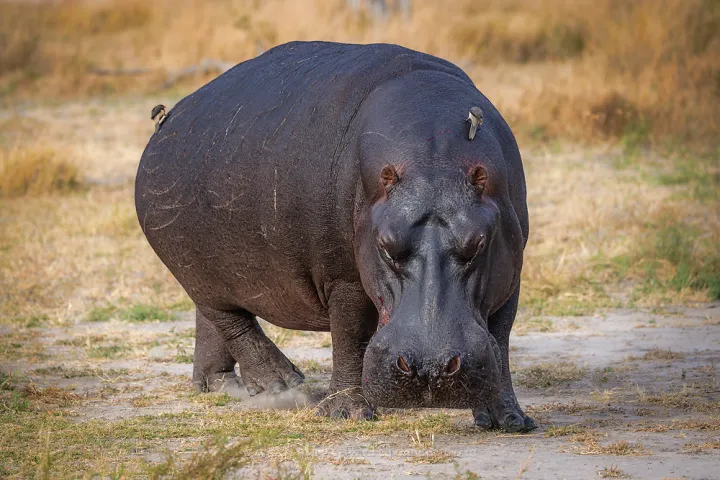African elephants are some of the most awe-inspiring creatures on the planet, known for their incredible size, intelligence, and deep emotional bonds.
Despite their iconic status, many people don’t fully understand the intricacies of these magnificent animals. From their unique physical traits to their vital role in ecosystems, there’s much more to elephants than meets the eye.
In this guide, we’ll dive deep into 50 incredible facts about African elephants that will leave you more amazed by these gentle giants than ever.
What are Fascinating Facts About Elephants?
1. Largest Living Land Mammal
The African elephant is the largest living land mammal on Earth. Male elephants, also known as bulls, can weigh up to 14,000 pounds (6,350 kg) and stand as tall as 13 feet (4 meters) at the shoulder. Females are generally smaller, weighing between 5,000 to 8,000 pounds. Their immense size makes them unparalleled in the animal kingdom, and their massive presence is felt wherever they roam.

2. Elephants are Eating Machines
Elephants spend up to 16 to 18 hours a day feeding, that nearly 80% of their day. Given their size, it’s no surprise that they must eat continuously to sustain their bodies. They are often described as “eating machines” because their daily routine revolves around finding and consuming food. Elephants are herbivores and consume a wide variety of vegetation, including grasses, leaves, bark, roots, and fruit.
3. In an Elephant’s Diet Bulk Matters
On average, elephants consume 250 to 300 pounds of food daily, but some individuals can eat as much as 600 pounds of food in a single day during periods of high abundance. Their diet is high in fiber but low in nutritional content, which is why they must consume such large quantities. In the wild, elephants play a crucial role in shaping their environment as they move through the landscape, consuming large amounts of vegetation and dispersing seeds through their dung.
4. Inefficient Digesters
Despite their voracious appetite, elephants digest their food with less than 50% efficiency. This means that much of what they eat passes through their digestive system without being fully broken down. To compensate, elephants must eat frequently and in large quantities, constantly foraging to meet their nutritional needs.
5. Manure Manufacturers
Elephants are prolific manure manufacturers, defecating 12 to 15 times a day. This results in the production of 220 to 250 pounds of dung daily. Their dung is not just waste—it plays a vital role in ecosystems by dispersing seeds, fertilizing the soil, and providing food for other animals like dung beetles. Elephants are essentially walking composters, enriching the environment wherever they go.
6. Methane Producers
Due to the large amount of plant material they consume, elephants produce substantial amounts of methane as their food ferments in their digestive system. It’s estimated that the methane produced by a single elephant in one day could fuel a car for 20 miles if properly harnessed. This highlights the ecological impact of elephants, even in ways that aren’t immediately visible.
7. Water Guzzlers
Water is essential for an elephant’s survival, particularly in the hot African climate. On average, an elephant drinks about 25 to 50 gallons (100–200 liters) of water per day. During particularly hot or dry periods, elephants may drink even more, especially after long migrations to water sources.
8. Trunk Efficiency
An elephant’s trunk is a highly versatile and efficient tool. It can hold up to 2.5 gallons (9.5 liters) of water, which the elephant can then siphon into its mouth. The trunk is a combination of the upper lip and nose and contains over 40,000 muscles, allowing for a range of delicate and powerful movements—from picking up small objects to uprooting trees.
9. Hairy Creatures
Despite their tough, leathery skin, elephants have hair all over their bodies. The hair is more noticeable in younger elephants, and as they age, it becomes sparser. This hair, especially around their ears and tails, plays a role in thermoregulation, helping elephants stay cool in hot climates.
10. Lash Protection
Elephants have long eyelashes that protect their eyes from dust, debris, and insects. Their eyes are sensitive, and the harsh environments they inhabit—often dry and dusty savannas—make these lashes a necessary defense mechanism.
11. Multifunctional Trunk
The elephant’s trunk is one of nature’s most versatile tools. It serves as a nose, hand, extra foot, signaling device, and food-gathering tool. Elephants use their trunks for a wide variety of tasks: to breathe, drink, grab objects, siphon water, dust themselves with sand, and even for social bonding through tactile communication.
12. Swimming Champs
Elephants are excellent swimmers and can use their trunks as a snorkel when crossing deep rivers or lakes. Their buoyant bodies and strong limbs make them capable of swimming long distances, and they enjoy spending time in the water to cool off and play.
13. Slow Heart Rate
Elephants have a surprisingly slow heart rate, averaging about 27 beats per minute. In comparison, a much smaller animal like a canary has a heart rate of about 1,000 beats per minute. Elephants’ slow heart rate is an adaptation to their large size, helping to maintain steady blood flow throughout their massive bodies.
14. Elephants Never Jump
Elephants are the only mammals that cannot jump. This is due to the structure of their legs, which are designed to support their enormous weight. Their bones lack the “spring” that many other animals use to leap. However, elephants don’t need to jump—they rely on their size, strength, and endurance to move through their environments.
15. Longest Pregnancy
Elephants have the longest pregnancy of any mammal, lasting an average of 22 months. This long gestation period allows the calf to develop fully in the womb, preparing it for life in the wild. Elephants give birth to one calf at a time, and twins are extremely rare.
16. Big Babies
Newborn elephants weigh between 200 to 300 pounds (90–136 kg) at birth, making them one of the heaviest newborns in the animal kingdom. Calves are born almost fully developed and can stand and walk within hours of being born, though they rely on their mothers for milk and protection.
17. Tusks That Grow for Life
Elephant tusks, which are elongated incisor teeth, continue to grow throughout an elephant’s life. In male elephants, tusks can weigh over 200 pounds each. Tusks are used for digging, foraging, stripping bark from trees, and as tools during social interactions and defense.
18. Tooth Giants
Elephants have some of the largest teeth of any animal. An elephant’s molar tooth can weigh as much as 7 pounds (3 kilograms). Throughout their lifetime, elephants will have six sets of teeth, which wear down over time due to their constant chewing of fibrous plants.
19. Massive Intestines
An elephant’s intestines can be 60 feet (19 meters) long, allowing them to process large quantities of plant material. Despite their inefficient digestion, their long intestines help maximize the absorption of nutrients from their high-fiber diet.
20. Communication Through Purring
Elephants communicate using a wide variety of sounds, including a deep, rumbling purr that is often too low for human ears to detect. These infrasonic sounds can travel long distances and are used to communicate between family members and other elephants across vast areas.
21. Elephants Can Learn Commands
Elephants are highly intelligent animals capable of learning and responding to over 60 commands. In captivity, elephants have been trained to perform complex tasks, though ethical considerations about the training and care of captive elephants are an ongoing concern.
22. Asian vs. African Tusks
While both male and female African elephants have tusks, only male Asian elephants typically have large tusks. Female Asian elephants may have small “tushes” that rarely extend beyond their lip line, making them much less noticeable.
23. Trunk Drinking Technique
Although it might seem like elephants use their trunks like straws, they suck water into their trunks and then pour it into their mouths. Their trunk can hold about 2.5 gallons of water at a time, making it a highly efficient drinking tool.
24. Large Family Units
Elephants live in matriarchal family groups, typically led by the oldest and most experienced female. These herds usually consist of related females and their offspring, while males leave the herd once they reach adolescence. The strong bonds within the family group are essential for survival, particularly during migrations or times of scarcity.
25. Elephants Grieve
Elephants are known to exhibit mourning behavior when a member of their herd dies. They will often return to the site where the elephant passed, gently touching the bones with their trunks. This emotional behavior reflects their deep social bonds and intelligence.
26. Sensitive Skin
Despite their thick and tough-looking skin, elephants have sensitive skin that is prone to sunburn and insect bites. To protect themselves, they cover their skin in mud, which acts as a natural sunscreen and insect repellent.
27. Massive Ears for Cooling
Elephants have large ears that are filled with blood vessels. By flapping their ears, elephants cool the blood in their ears, which helps regulate their body temperature. This cooling mechanism is especially important in the hot African sun.
28. Longevity in the Wild
Elephants have a relatively long lifespan, often living up to 60 or 70 years in the wild. Older elephants, especially matriarchs, are vital to the survival of their herd because they possess invaluable knowledge about water sources, migration routes, and survival strategies during droughts.
29. Big Brains, Big Intelligence
Elephants have the largest brains of any land mammal, weighing between 10 to 12 pounds (4.5–5.5 kg). Their large brains are associated with high levels of intelligence, problem-solving skills, and emotional complexity. Elephants are capable of using tools, solving puzzles, and displaying self-awareness.
30. Memory Like an Elephant
The phrase “an elephant never forgets” holds some truth. Elephants are known for their incredible memory, which allows them to remember the locations of waterholes, migration routes, and even other elephants they haven’t seen in years. This memory is especially important for the matriarch, who leads the herd to resources during times of drought.
31. Unique Identifiable Tusks
Just like human fingerprints, an elephant’s tusks are unique to each individual. No two tusks are the same, and researchers can identify specific elephants based on the size, shape, and wear patterns of their tusks.
32. Quiet Giants
Despite their size, elephants can move almost silently through their environment. Their padded feet allow them to tread softly, which is helpful when they are approaching waterholes or traveling in groups. This quiet movement also allows them to avoid attracting attention from potential threats.
33. “Finger” Tips on Trunks
African elephants have two finger-like projections at the tip of their trunk, while Asian elephants have just one. These finger-like extensions allow elephants to grasp small objects, pluck leaves, and manipulate tools with precision, giving them a fine-tuned sense of touch.
34. Loyal to Home Ranges
Elephants are highly loyal to their home ranges and will pass down knowledge of these areas through generations. Elephants often follow the same migration routes, passed down from mothers to daughters, ensuring their survival by relying on long-remembered resources like waterholes and food-rich areas.
35. Threatened by Ivory Poaching
One of the greatest threats to African elephants is poaching for their ivory tusks. Despite international bans on the ivory trade, illegal poaching persists, and many elephants are killed each year for their tusks. Conservationists continue to fight for stronger enforcement and protections to safeguard elephants from extinction.
36. Big Drinkers
Elephants need a substantial amount of water to survive, especially during hot weather or droughts. A single elephant can drink up to 100 liters (26 gallons) of water in one sitting, often visiting water sources multiple times a day to stay hydrated.
37. Elephants Make Tools
Elephants are one of the few animals known to make and use tools. They have been observed using sticks to scratch themselves, breaking branches to create fly swatters, and using leaves or bark to test water depth. This tool-making ability is another indication of their intelligence and adaptability.
38. Social Hierarchies in Herds
Elephant herds have complex social hierarchies. The matriarch leads the herd, but younger females also play important roles, especially in caring for calves. Male elephants, known as bulls, usually leave the herd after puberty and either live solitary lives or join small bachelor groups.
39. Matriarch Wisdom
The matriarch is often the oldest and wisest member of the herd. Her wisdom—gained through years of experience—is crucial during tough times, such as droughts or migrations. She leads the herd to water and food, ensuring their survival.
40. Foot Communication
Elephants can detect vibrations through their feet, allowing them to communicate over long distances. By picking up seismic signals in the ground, elephants can sense the approach of other elephants or even thunderstorms, giving them an advantage in finding water and avoiding danger.
41. Eco-Engineers
Elephants are considered eco-engineers due to their significant impact on their environment. As they move through the landscape, they knock down trees, create paths, dig for water, and disperse seeds through their dung. These actions help maintain the health and diversity of ecosystems, benefiting countless other species.
42. Herd Sizes
Elephant herd sizes can vary greatly, ranging from small family groups of 8 to 12 individuals to larger groups of up to 100 elephants during migrations or when resources are abundant. The size of a herd depends on factors like food availability, water access, and the presence of predators.
43. Family-Oriented
Elephants are highly family-oriented animals. Allomothers—females who help care for calves—play an important role in the herd. They assist in raising young elephants, providing protection and guidance, which helps ensure the survival of the next generation.
44. The Role of Bull Elephants
While female elephants remain in their family herds, male elephants leave the herd when they reach adolescence. They may live solitary lives or form small bachelor groups with other males. Bulls occasionally return to female herds during mating season, but otherwise, they lead more independent lives.
45. Must Period for Males (Mating Behavior)
Mature male elephants go through a phase called musth, during which they experience a surge in testosterone levels. Musth makes males more aggressive and competitive as they seek out mates. During this period, males are highly dominant and may engage in fights with other bulls.
46. The Elephant is the National Animal of Thailand
The elephant holds great cultural significance in many parts of the world. In Thailand, the elephant is the national animal and symbolizes strength, endurance, and royal power. Elephants are also featured in religious ceremonies and historical traditions.
47. Night Vision
Elephants have relatively poor night vision, but their acute sense of smell and hearing help compensate for this. Elephants are known to be more active during the cooler hours of the day and night, relying on their heightened senses to navigate in low light conditions.
48. Symbiotic Relationships
Elephants have symbiotic relationships with smaller animals, such as oxpeckers, which eat parasites off their skin. In return, the birds benefit from a steady source of food. These relationships help keep elephants healthy and create mutual benefits for other species.
49. Save the Elephants
There are fewer than 400,000 African elephants left in the wild today, a significant decline due to poaching, habitat loss, and human-wildlife conflict. Conservation efforts are critical to ensuring their survival, including anti-poaching initiatives, habitat protection, and educating communities about coexisting with elephants.
50. Elephants Around the World
While African elephants are more numerous, their cousins, the Asian elephants, are far more endangered. Only about 50,000 Asian elephants remain in the wild, with approximately 13,000 living under human care in zoos, sanctuaries, and with private owners across their range countries.
Conclusion
African elephants are not just iconic symbols of the wild—they are keystone species whose presence is vital to maintaining the balance of ecosystems across Africa.
An elephant’s intelligence, emotional depth, and environmental impact make them one of the most remarkable animals on Earth. However, the challenges they face from poaching, habitat loss, and climate change mean that it is more important than ever to protect and conserve these gentle giants for future generations to admire and appreciate.
By learning more about these incredible creatures and supporting conservation efforts, we can all play a role in ensuring that African elephants continue to roam the savannas and forests for years to come.





